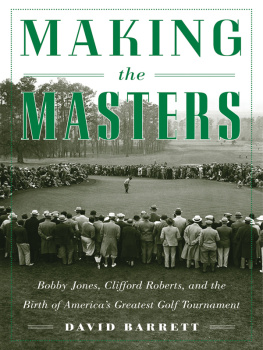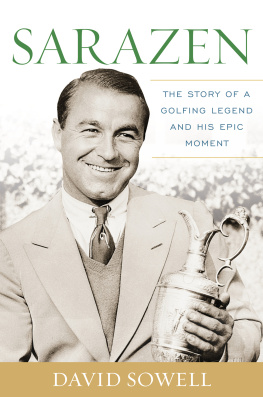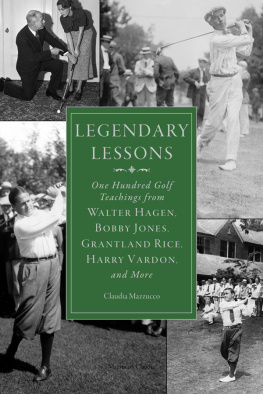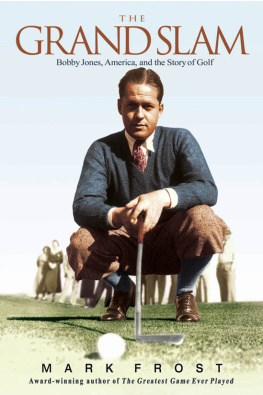Also by David Barrett:
Golf Magazines Golf Rules Explained
Golf Courses of the U.S. Open
Golfing with Dad
Golfs Dream 18s
Miracle at Merion
The PGA Championship: 19161985 (contributor)
Golf In America: The First 100 Years (contributor)
Golf the Greatest Game: The USGA Celebrates Golf in America (contributor)
20th Century Golf Chronicle (contributor)
Golf Legends of All Time (contributor)
The Wit & Wisdom of Golf (contributor)
Best of Golf (contributor)
These Guys Are Good (contributor)
The Love of Golf (contributor)
Copyright 2012 by David Barrett
All Rights Reserved. No part of this book may be reproduced in any manner without the express written consent of the publisher, except in the case of brief excerpts in critical reviews or articles. All inquiries should be addressed to Skyhorse Publishing, 307 West 36th Street, 11th Floor, New York, NY 10018.
Skyhorse Publishing books may be purchased in bulk at special discounts for sales promotion, corporate gifts, fund-raising, or educational purposes. Special editions can also be created to specifications. For details, contactthe Special Sales Department, Skyhorse Publishing, 307 West 36th Street, 11th Floor, New York, NY 10018 or info@skyhorsepublishing.com.
Skyhorse and Skyhorse Publishing are registered trademarks of Skyhorse
Publishing, Inc., a Delaware corporation.
Visit our website at www.skyhorsepublishing.com.
10 9 8 7 6 5 4 3 2 1
Library of Congress Cataloging-in-Publication Data is available on file.
ISBN: 978-1-61608-609-1
Printed in the United States
For Luda, Michael, and Sophia, and for my mom, Virginia
INTRODUCTION: THE LITTLE BIG TOURNAMENT
I N EARLY APRIL EACH year the eyes of the golf world are transfixed on Augusta, Georgia, and the Masters Tournament. Even casual golf fans heed the sirens call, as evidenced by television ratings that out-shine all other golf events.
For the serious fan, attending the Masters is a lifelong dreambut one rarely fulfilled because tickets are nearly impossible to come by via official channels. There is such demand even for practice-round tickets that they are dealt out by a lottery.
The games elite players covet the Masters title more than any other. True, American players might dream equally of winning the U.S. Open and international players may have their hearts set on the British Open. But for universal appeal among players around the world, the Masters is it.
Yet given its stature in the golf world today, the Masters had surprisingly humble beginnings.
The tournament had to ask the city of Augusta for financial help to run the first Masters in 1934. Without that $10,000 in aid, it might not even have gotten off the ground. The city only agreed to give the money in order to boost the tourist trade at its winter resort hotels.
Even at that, tournament chairman Clifford Roberts had to pass the hat among members at Augusta National Golf Club to individually contribute the prize money for the players. The host club had used up its tournament funds in preparations for the event.
The clubhouse was barely adequate. Members had planned to tear down the smallish original 1854 building in favor of a new clubhouse but funds couldnt be raised and the old manor house was kept.
A few top players didnt play in the inaugural Masters, most notably Gene Sarazen and Tommy Armour. Sarazen had already scheduled an exhibition tour of South America and Armour couldnt get away from the club-pro duties that occupied him for part of the year.
The galleries amounted to little more than a thousand people per day, even with full-week passes going for $5.50 and daily tickets for $2.20.
After more than two years of existence, Augusta National still had fewer than eighty members. That led to a serious shortage of funds. In 1934, it was nearly two years overdue in paying many of its bills from course construction. The Masters was devised largely as a way to gain publicity for the club and thus draw a sufficient number of new members for it to be able to survive financially.
It didnt really work. Membership picked up only slightly, and shortly after the second Masters, Roberts wrote a letter to the mayor of Augusta saying that there would be no third Masters without continued support from the city while also complaining about a cut in support from $10,000 to $7,500 in the previous year.
Augusta National survived, but only because it had a trick up its sleeve. There being little, if any, competition in bidding on golf course property during the Depression, a bank foreclosure on the club allowed a group of its members to purchase the property in June 1935 at auction at less than half the cost of four years earlier. A new corporation was formed, enabling the club to escape its creditors. That, in turn, helped the Masters to keep going.
Yet, at the same time, the Masters had grand beginnings.
The inaugural event marked the return to competition of Bobby Jones, the founder and president of Augusta National. This was a huge deal. Jones had retired after winning the Grand Slamthe U.S. Open and Amateur and British Open and Amateurin 1930. But in 1934, he was still only thirty-two years old. Even if his comeback was to be limited to the Masters, it was widely felt that he could still hold his own or even prove that he was still the best. In any case, there was great curiosity about how he would do.
As a result of interest in Jones, the first Masters rivaled the U.S. Open in receiving the most press coverage of any tournament that year (the Augusta Chronicle reported that more words were transmitted by telegraph from the Masters than the prior years U.S. Open). There were writers in town from New York and Chicago, nationally syndicated columnists were on hand, and the wire service coverage far exceeded that of a regular golf tournament. The Associated Press had its national sports editor and another writer reporting with in-depth stories that were placed at the top of sports pages around the nation. And the 1934 Masters was just the second tournament to receive live national radio coverage.
Within a couple of years, people were saying that the Masters was the tournament players most wanted to win, along with the U.S. Open. There was no real concept of four professional majors in those days. But clearly, the Masters was already No. 2, or even co-No. 1, in prestige.
The first Masters was won by Horton Smith, a top-notch player once hailed as the next Bobby Jones. The second was won by Sarazen, probably the best player, and certainly the biggest star, of the day.
Sarazen won that 1935 tournament thanks largely to holing a shot from 230 yards for a double eagle, a feat so spectacular it was called the Shot Heard Round the World. This served to spread Masters fame far and wide and helped to sustain the standing of the tournament even as it was clear that Jones would not be a competitive threat.
The tournament was held on a course co-designed by Jones and Alister MacKenzie, one which rapidly earned a reputation as one of the best in the country. Its design, which challenged the best players in the world while also allowing for heroics like Sarazens, proved perfect for producing the kind of excitement that would help the tournament become the most-watched golf event in the world once the television era came along.
The humble aspects mostly stemmed from the fact that Augusta National and the Masters were launched during the Depression, hardly the best time to start such ventures. And besides, golf wasnt then the big deal it later became. Tournaments didnt draw anything near the galleries they do todaya thousand was a good crowdand $5,000 purses were the norm.
Next page










